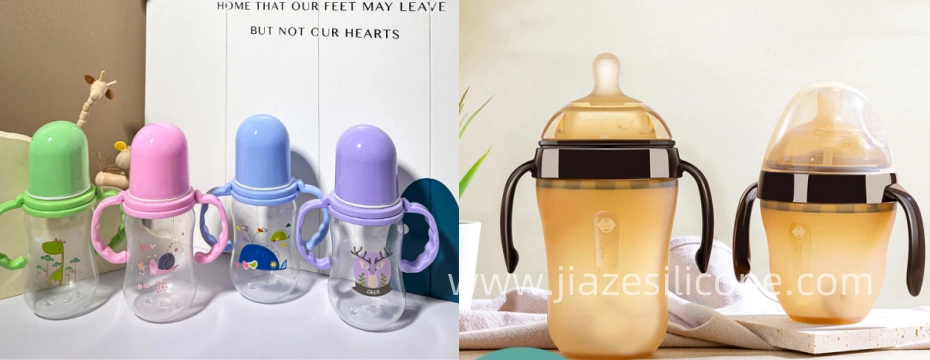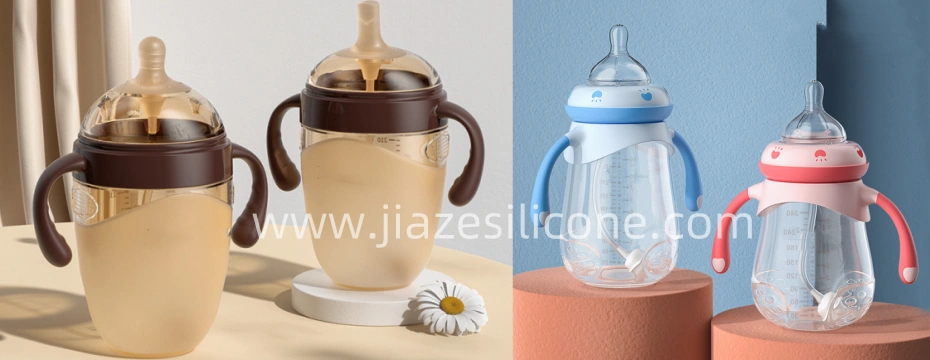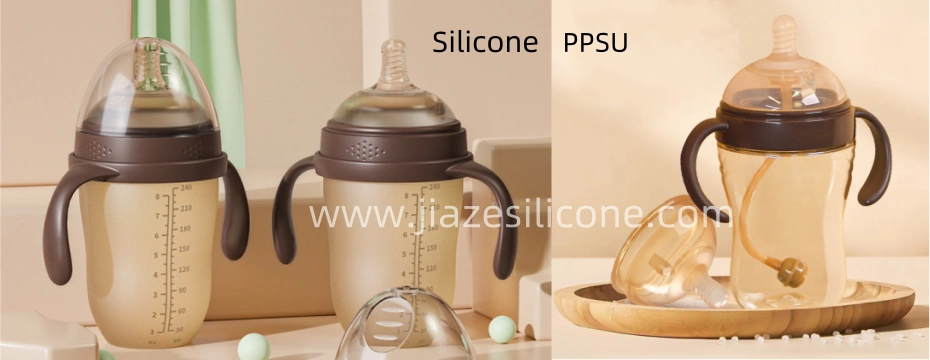Baby bottles are an essential tool for feeding infants, and parents are often faced with the challenge of choosing the best option. Two popular choices are silicone and plastic baby bottles, each with unique features, benefits, and drawbacks. This guide compares these materials across key factors such as safety, durability, ease of use, environmental impact, and cost to help parents make an informed decision.

1. Material Composition
Silicone Baby Bottles:
- Made from medical or food-grade liquid silicone rubber, a synthetic polymer known for its flexibility, durability, and heat resistance.
- Silicone is free of harmful chemicals like BPA, phthalates, and PVC, making it a safe option for infants.
Plastic Baby Bottles:
- Typically made from polycarbonate, polypropylene, or polyethylene.
- Many modern plastic bottles are labeled BPA-free to address safety concerns, but they may still contain other chemical compounds that could degrade over time.
2. Safety and Health Concerns
Silicone Baby Bottles:
- Highly regarded for their safety, as silicone is inert and does not release harmful substances when heated.
- Resistant to microbial growth, which is crucial for maintaining hygiene.
- Soft and flexible, reducing the risk of injury if a bottle is dropped during feeding.
Plastic Baby Bottles:
- While BPA-free options are widely available, concerns remain about other potential chemical leaching, especially when exposed to high temperatures during sterilization or heating.
- More prone to scratches, which can harbor bacteria and make thorough cleaning challenging.
3. Durability
Silicone Baby Bottles:
- Extremely durable and resistant to cracking or breaking, even when dropped.
- Retain their shape and integrity over long-term use, even under frequent sterilization.
- Softer material may be more susceptible to bite marks if the baby chews on the bottle.
Plastic Baby Bottles:
- Lightweight and durable under normal use, but more prone to scratches, warping, or discoloration over time.
- Can crack or break under certain conditions, especially if exposed to high temperatures repeatedly.
4. Ease of Use
Silicone Baby Bottles:
- Slightly heavier than plastic bottles but offers a soft, easy-to-grip texture for both parents and babies.
- Flexible material makes them ideal for travel, as they can be squeezed to extract air or liquids.
- May require more effort to clean thoroughly due to their flexible design.
Plastic Baby Bottles:
- Lightweight and easy to handle, making them a convenient choice for parents on the go.
- Typically have a rigid structure, simplifying cleaning and sterilization.
- Available in a wide range of shapes, sizes, and designs to suit different preferences.

5. Temperature Resistance
Silicone Baby Bottles:
- Can withstand extreme temperatures, making them suitable for boiling, microwaving, or freezing.
- Retain their structural integrity even after repeated exposure to heat or cold.
Plastic Baby Bottles:
- Generally less heat-resistant than silicone and may warp or degrade if exposed to high temperatures frequently.
- Some types of plastic are not microwave-safe or suitable for boiling.
6. Environmental Impact
Silicone Baby Bottles:
- Considered more environmentally friendly due to their durability and long lifespan, reducing the need for frequent replacements.
- While not biodegradable, silicone can be recycled through specialized programs.
Plastic Baby Bottles:
- Often less eco-friendly due to their shorter lifespan and susceptibility to damage, leading to more waste.
- Many plastics are difficult to recycle, and improper disposal contributes to environmental pollution.
7. Cost
Silicone Baby Bottles:
- Generally more expensive upfront due to the high-quality material and manufacturing process.
- Long-term costs may be lower as they last longer and require less frequent replacement.
Plastic Baby Bottles:
- Typically more affordable, making them accessible to a broader range of consumers.
- Frequent replacements due to wear and tear can increase the overall cost over time.
8. Aesthetic and Design Options
Silicone Baby Bottles:
- Often feature modern, minimalist designs with a smooth and sleek finish.
- Limited in color variety due to the material’s inherent properties.
Plastic Baby Bottles:
- Available in a wide range of colors, patterns, and designs, appealing to parents who prioritize aesthetics.
- Customizable options, such as printed measurements and playful motifs, are more prevalent.
9. Maintenance
Silicone Baby Bottles:
- Resistant to stains and odors, making them easier to maintain over time.
- Slightly more challenging to clean in narrow areas due to the flexible material.
Plastic Baby Bottles:
- Easier to clean initially but more prone to staining and retaining odors from milk or formula.
- Scratches and cloudiness over time can make them appear worn and less hygienic.

10. Suitability for Specific Needs
Silicone Baby Bottles:
- Ideal for parents seeking a safe, durable, and long-lasting option.
- Recommended for babies transitioning from breastfeeding, as the soft texture mimics the feel of skin.
Plastic Baby Bottles:
- Suitable for parents on a budget or those who prioritize lightweight and portable options.
- Available in a broader range of shapes and sizes to cater to diverse feeding preferences.
Conclusion
Both silicone and plastic baby bottles have distinct advantages and disadvantages, and the choice ultimately depends on individual priorities and needs. Silicone bottles excel in safety, durability, and environmental friendliness, making them an excellent choice for long-term use and for parents who prioritize health. On the other hand, plastic bottles offer affordability, a wide range of designs, and lightweight convenience, making them suitable for families looking for budget-friendly options.
Parents should consider factors such as budget, lifestyle, and specific feeding requirements when choosing between silicone and plastic baby bottles. Regardless of the choice, selecting high-quality, BPA-free, and properly maintained bottles ensures a safe and comfortable feeding experience for the baby.